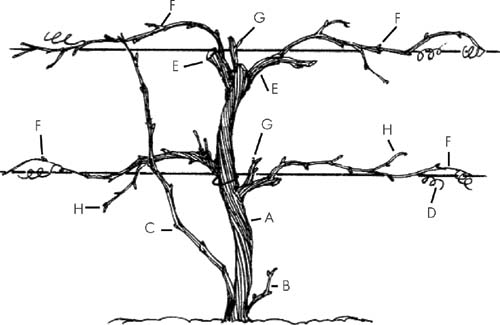Great Grapes
Grow the Best Ever
Annie Proulx
CONTENTS
Introduction
For most growers, the triumph of harvesting fragrant clusters of dusky-bloomed grapes in rose, blue-black, amber, purple, or light red bunches is its own reward a test of gardening skill. Grapes are among the most desirable and best known fruits on earth, prized for their beauty, their place in classical legend and mythology, their succulence and varied flavors as luxury table fruits, their noble metamorphosis into wine, and their more utilitarian roles as sources of fresh juice and tasty jellies.
Grapes are a labor-intensive specialty crop, best grown by a patient, careful gardener with a feeling for the vine. Properly grown and ripened grapes are always in demand and bring good prices in the market and at roadside stands. This is one area where commercial growers cannot compete with the dedicated, small vineyard tiller who can best give the vines the attention they need to produce high yields of quality fruit. Growing grapes is a good way to augment your regular income, as well as stock a wine cellar and the pantry shelves if you have the proper site and an inclination for this vine.
This bulletin will tell you how to grow grapes from planting to harvesting.
Who Can Grow Grapes?
Grapes have the reputation of being fragile and difficult to grow. Many northern gardeners, convinced that all grapes are too tender for their fierce winters and uneven spring temperatures, do not even consider trying to grow them, yet some vines will flourish in regions of every state and in several Canadian provinces. Since 1843 when Ephraim Bull of Concord, Massachusetts, finally succeeded in breeding the native grape he named for his town, after more than 20,000 tries, grape breeders, and hybridizers have developed literally thousands of different grape varieties suited to an amazing range of climates and soils. A good rule of thumb is that if wild grapes grow in your area, you can grow plump and tasty domestic grapes of some kind.
Even in New England, successful commercial and amateur vineyards are proliferating. Several winemakers in the best southern New England sites are actually growing Vitis vinifera, the prima donna European wine grapes a gardening feat once believed impossible in this region. Hardier cultivars (cultivated varieties), such as the Beta and Blue Jay will grow in the northern states and southern Canada, bred to withstand winter temperatures that plunge to 30F below zero! Really determined vine growers can coax even the most delicate vines to fruition in a hothouse. In an especially sheltered, sunny, well-drained site an optimum microclimate you may be able to grow cultivars beyond their normal range. Northern grape growers have worked out wine growing, or viticultural, practices that protect and encourage their vines despite frost and snow. In the South Atlantic and Gulf states, Muscadine grapes will succeed where other cultivars cannot.
You can grow grapes successfully if:
 You choose the most suitable cultivars for your area, grapes that will ripen before killing frosts get them, or that will withstand hot, humid summers.
You choose the most suitable cultivars for your area, grapes that will ripen before killing frosts get them, or that will withstand hot, humid summers.
 You plant them in the most sunny, sheltered, well-drained place possible.
You plant them in the most sunny, sheltered, well-drained place possible.
 You learn and practice every special growing technique that will give you and your grapes the edge over climatic vagaries.
You learn and practice every special growing technique that will give you and your grapes the edge over climatic vagaries.
 Dont give up if one variety fails to flourish. Only trial and error will enable you to match the best cultivar to your vinery.
Dont give up if one variety fails to flourish. Only trial and error will enable you to match the best cultivar to your vinery.
The Best Climate
The best grape climates are regions where the growing season is 150 to 180 days, where relative humidity is low, and where summer rains are sparse rather than frequent. A week of cloud and rain in the final week of ripening may result in extensive crop losses.
Grape Yields
 10 Concord vines grown 8 to 10 feet apart will yield about 50 quarts of juice a year.
10 Concord vines grown 8 to 10 feet apart will yield about 50 quarts of juice a year.
 Each vine of bunch grapes will give between 5 and 15 pounds of fruit every season.
Each vine of bunch grapes will give between 5 and 15 pounds of fruit every season.
 One to two bushels of grapes yields enough juice to fill a 5-gallon carboy.
One to two bushels of grapes yields enough juice to fill a 5-gallon carboy.
Grape growing will be difficult or impossible in arid desert regions without irrigation, in places with extremely short growing seasons, or with very severe winter temperatures.
Something to Think About
You should have a good idea of what you will do with your grape crop before your vineyard gets off paper. A quarter-acre of vines about 100 plants can give you a ton of fruit at harvest time. A ton of grapes fills 50 to 60 bushel baskets. Depending on the grape cultivar, this means up to 200 gallons of juice or wine.
If you are thinking of growing grapes commercially, even on a small scale, you should know that the costs of establishing a vineyard (posts, wire, vines, pesticide sprays, and hired labor) are estimated at about $4,500 an acre. The major cost is in the hired labor. Cultivation, vine training, pruning, pest control must all be done when the vines need it, or the crop may fail. The home grower who can attend to his or her vines without hiring paid help is way ahead of the game. Remember, too, that it takes three to four years before the vines will produce a crop.

The major parts of a grapevine consist of the trunk (A), suckers (B), young replacement trunk (C), tendril (D), arm (E), cane (F), spur (G), and shoot (H).
Grape Growers Vocabulary
Arms: The favored canes left on the vine after the rivals are pruned off. These arms produce fruiting shoots and canes for next year. After a seasons production they are usually pruned off during the next dormant season and replaced.
Canes: The mature shoots late in the season. The word also means the year-old dormant wood of the preceding season. Most canes are pruned out during the dormant period before the new growth begins in the spring.
Cordon:See Trunk.
Cultivar: A cultured variety of plant especially developed for commercial or domestic cultivation. Cultivar is just a short form of cultivated variety.
Renewal canes:See Spurs.
Shoots: The young, succulent growth of the present season. Shoots grow from last seasons buds and send out leaves, flowers, and fruit. When mature, they become the fruiting canes of the next season.
Spurs: Short, one- or two-bud canes deliberately left on the vine to become the arms and canes of the future.
Stripping: The process of removing all new growth in the event of frost damage.
Trellis: A number of wires strung on posts to support the fruiting arms of the vine.
Trunk: The main stock of the plant, also called the cordon. Some tender varieties may have two, or even three, trunks.
Basic Grape Types
There are basically three types of grapes: native wild grapes, Vitis vinifera

















 You choose the most suitable cultivars for your area, grapes that will ripen before killing frosts get them, or that will withstand hot, humid summers.
You choose the most suitable cultivars for your area, grapes that will ripen before killing frosts get them, or that will withstand hot, humid summers.